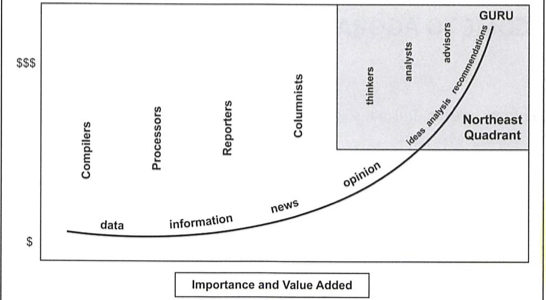My view of how to effectively present and package info-products and content has changed radically over the last year…
Because, how you package and present your “information” and content determines how valuable prospects perceive it to be, what they’re willing to pay for it, and how it positions you in the marketplace.
Let me show you what you need to do today to ensure your info-products and content stand-out… and position you as a valuable expert and guide.
Let’s begin with a little chart:

What it shows is how valuable different types of content are and the financial opportunity of each.
For example…
While curated content, compiled lists, random tips, etc., are good for getting likes and social shares, they have the lowest level of value for info-products and marketplace positioning.
Meaning: That type of content commands a very low price tag… and does little if anything to position you as an authority.
That’s because, today, this type of information is pervasive. It’s available all over the web. And for free.
Fact is: Today, you can find “information” on any topic, at any time, on the web… in minutes. If not, seconds.

And that’s why this type of content is worth very little as an info-product. And why it will not position you as an expert or go-to advisor in your marketplace.
What buyers of info-products want… is NOT more “information”. They want original and specific advice and direction.
And the more specific and proprietary the advice, the more it’s worth. And the higher it can be priced.
That’s why I believe, today, the single best way to package your “information” is in the context of a framework.
A framework being a specific & proprietary methodology for obtaining an outcome or result, presented with a visual model.
Done correctly, you can build an entire business — a monster business — around a single framework.
Think, Stephen Covey’s Time Management Quadrant…

…or Robery Kiyosaki’s Cashflow Quadrant…

Both provide a specific methodology for achieving a desirable outcome with a simple framework.
There’s no list of tips. No random, additional ideas. And no general information.
And that’s why both of these frameworks have been worth hundreds of millions of dollars. And have made Covey and Kiyosaki rich, highly-sought-after experts.
You see: By packaging your “information” within a framework, you immediately position it as unique and different. You immediately prevent any kind of apples to oranges comparison. And you immediately become viewed as an expert with a specific method of achieving a desirable result.
Here’s another example. Something called “The IIO Framework” from Frank Kern…

And an example from Brendon Burchard of his High Performance Framework…

And here’s my main framework at MFA — The E5 Funnel Architecting Framework…
See: By offering your specific advice in the form of a framework you push your “information” to that Northeast Section of the Value Hierarchy Chart (above). So it instantly becomes viewed as more valuable, more desirable, and more sellable.
And that’s the key making your content standout and positioning yourself as an expert in your marketplace.
Simply put: Don’t offer more “information”. Offer a unique framework that will give your prospects the results they want.
The post The Hierarchy Of Value For Info-Products appeared first on Marketing Funnel Automation.










